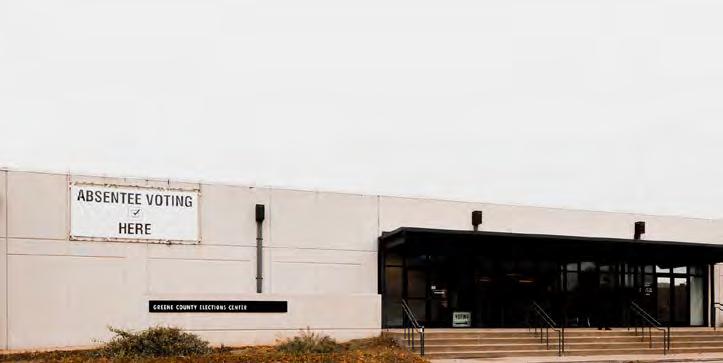
2 minute read
What is the Electoral College? Greene County polling places
Greene County central polling places
Diana Dudenhoeffer | Digital Editor | @kisstein | Photo by Leah Stiefermann/THE STANDARD
The polling place closest to most Bears is JQH Arena,
located at 685 S. John Q. Hammons Parkway. Other polling
places include CU Transit Center at 211 N. Main Ave., Cox South Hospital at 3801 S. National Ave. and Mercy Hospital at 1235 E. Cherokee St. All polling places are open
6 a.m. to 7 p.m., according to the Missouri Secretary of State
website. For a full list of polling places, visit the Greene
County Clerk Office’s website.
What is the Electoral College and how does it impact elections?
Desiree Nixon | News Editor | @DesireeNixon17| Illustration by Jadie Arnett/THE STANDARD
In the United States, the founders set up an election process in Article Two of the Constitution. This set up the Electoral College, the United States’ way of electing the president. The general election happens every four years, when citizens go to cast their vote; however, their vote is not what determines who wins. Instead, the Electoral College determines the outcome of the general election.
According to the National Archives, the Electoral College is a process, not a group. This is a process that involves a group of people from each state called electors casting a vote for who they think deserves to be president.
“It is not a direct democracy because that’s not the way the founding fathers set up our electoral system,” Nick Beatty, political science professor at Missouri State University, said. “They were concerned ignorant voters would select bad candidates for president, so they created the Electoral College for presidential races, which was supposed to protect us from our ignorant selves.”

ity Missouri has the same number of electors as it does members in Congress: eight electors for the eight members in the House of Representatives, plus two Senators. The U.S. has what is called a ‘first-pastthe-post’ democracy, which means whoever gets the most votes - even if that total is less than 50% of all votes cast- wins the election,” Beatty said. “It is not a direct democracy.” Although the United States election system is not a direct democracy, typically the popular vote and electoral votes have the same outcome.
“There have been instances when the person who won the popular vote did not win the electoral vote – 1824, 1876, 1888, 2000 and of course, 2016,” Beatty said.
In 2016, Donald Trump won 304 electoral votes compared to Hillary Clinton’s 227. However, Trump only received 46.1% of the popular vote while Clinton received 48.2%, according to the Federal Election Commission.
Although there have been more recent examples of conflicts between the Electoral College versus the popular vote, there are many people who support it.
“Proponents of the Electoral College claim it preserves some degree of representation – a voice – for the less populous states in the country,” Beatty said. “Otherwise, the states with high-population cities would control the outcome of elections.”
Through our election process, there are two main parties that dictate the majority of election outcomes.
“We have a two-party system that reduces the viable options available for voters, so anyone on the right of the political spectrum feels compelled to vote Republican and those on the left feel compelled to vote for Democrats,” Beatty said.
For more information on the Electoral College, visit the National Archives website.










